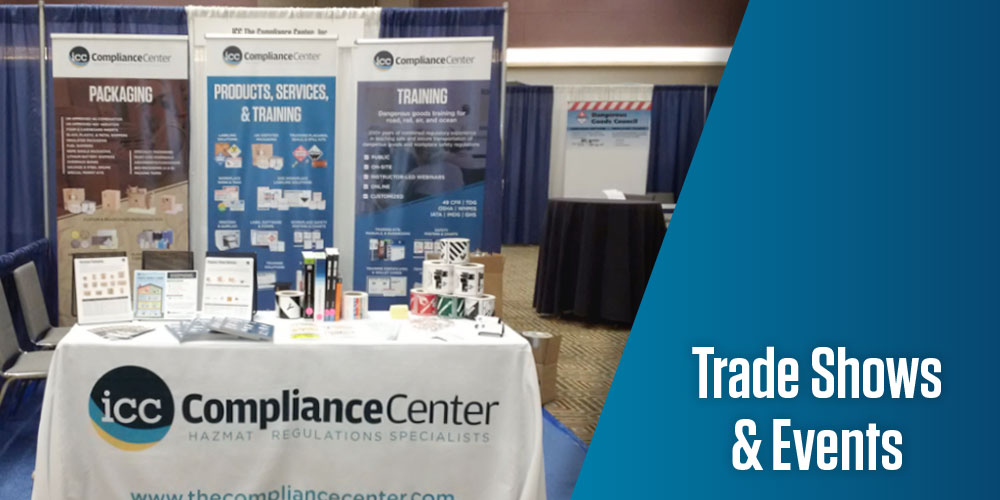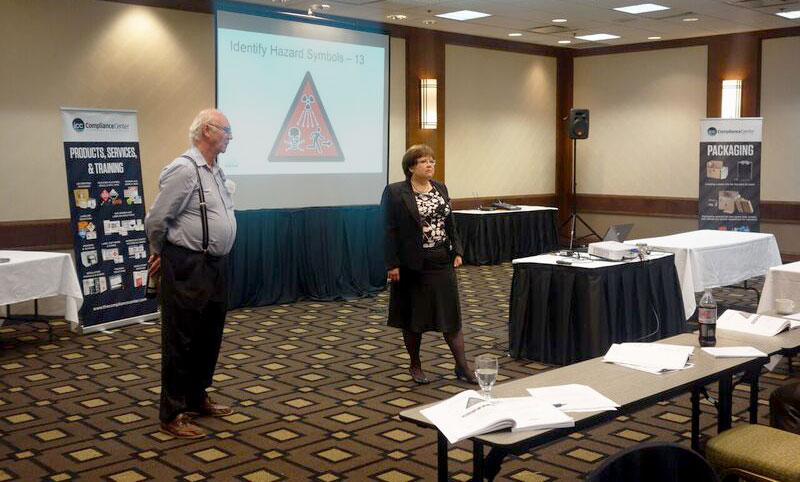
2nd Dangerous Goods Conference
On April 28, 2017, IDC Technologies held their second Dangerous Goods Conference in Mississauga, Ontario. Two of our regulatory staff from ICC were among the presenters during a day of informative sessions that covered transportation, environmental, and safety aspects of the Transportation of Dangerous Goods Regulations (TDG).
ICC Regulatory Consultant Clifton Brown presented his study of the effect the current lithium battery regulations are having on air safety, with a look over the history of accidents involving these batteries since they were first introduced in the early 1990s. Clifton did a lot of sifting through reports from government and industry sources to conclude that the regulations on lithium batteries have a way to go to make them a negligible hazard. Perhaps by the time they are, we’ll have invented safer methods of energy storage.

Clifton Brown and Barbara Foster at DGC 2017
I presented an overview of the Globally Harmonized System (GHS) changes to health and safety regulations, and whether the GHS Purple Book has achieved worthwhile harmonization in the same way as the UN Recommendations on the Transport of Dangerous Goods (the Orange Book). Unfortunately, we’ll have to deal with a lot of disharmonization remaining in the short term (such as the differences on dealing with environmental hazards between North America and Europe). However, the Orange Book has, slowly but surely, led regulators to remove many of these impediments to international transportation. Let’s hope the Purple Book serves as a good signpost to true harmonization.
Other Speakers Present:
- Dale Gration, Manager of Transportation of Dangerous Goods Ontario Region, Transport Canada, gave an interesting summary of current and upcoming Transport Canada amendments to the Transportation of Dangerous Goods (TDG) Regulations.
- Pierre Boies, President of Gestion Sécure P. Boies Inc. spoke on the effects of the Air Cargo Security Program. Pierre discussed general requirements as well as security aspects for dangerous goods.
- Mark Roehler, Principle, LEHDER Environmental Services Ltd, gave his perspective on the similarities, as well as considerable differences, in classification of hazardous waste under the environmental regulations as compared to TDG. He gave special attention to classification under Ontario’s Regulation 347, but stressed that each province has its unique features.
- Michel Hachey, Chief Technical Communicator, MG Chemicals, took a chemist’s look at the environmental effects of toxic metals in the environment. Many metals may be marine pollutants for transportation, but the classification can depend on multiple factors such as the size of the metal particles. As a chemistry major, I found this session particularly interesting.
- Amber Rushton, National Manager, Emergency Management Lead of the Ontario Association of Emergency Managers, OAEM, took us through the role of the professional emergency manager. The emergency manager, she stressed, is an essential part of a coordinated emergency response effort, helping all parts of the system function effectively together.
- Finally, Greg Fulford of Nordion addressed the unique requirements for transporting Class 7 radioactives, which involves combining TDG with other regulations such as the “Packaging and Transportation of Radioactive Substances Regulations.” When it comes to regulatory oversight, it appears some classes of dangerous goods are more equal than others, and Class 7 is the most equal of them all.
A Fun and Useful Experience
There were a couple of aspects that made this conference more fun and useful than many others. First, IDC not only provided copies of the presenters’ programs, but requested presenters to put their findings into a written paper. Both the papers and the PowerPoint presentations were assembled into a handy softbound book, rather than the standard binder. Even better, presenters were encouraged to make their presentations interactive by including activities for the audience. I was called upon by Greg Fulford to help assemble a box of mock radioactives, only to flub the security tape part. Hint for those using it – get someone to help you by holding the box flaps down. Once the tape is on, it will tell if you try to reposition it – no second chances allowed.
We’re grateful to IDC for inviting us to participate in this conference. If you’re looking for information on upcoming trends in the transportation of dangerous goods, you might want to consider attending next time it’s offered. For a one-day session, the selection of topics was excellent and the speakers were all well-informed as well as skilled at presentation.
If you have questions about dangerous goods, please contact ICC Compliance Center at 1-888-977-4834 (Canada) or 1-888-442-9628 (USA).






 ICC USA
ICC USA ICC Canada
ICC Canada